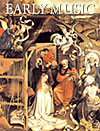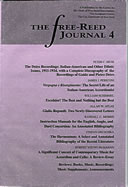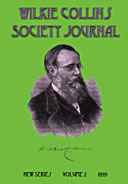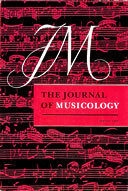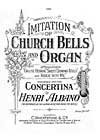Free-Reed Renaissance
Allan Atlas
Contributions to the Concertina Library by Allan Atlas.
-
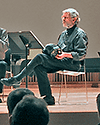 The Victorian Concertina: Some Issues Relating to Performance
The Victorian Concertina: Some Issues Relating to Performance
- by Allan W. Atlas
- Present-day players of the ‘English’ concertina must make a number
of important decisions when delving into and performing the large repertory of
art music that was written for the instrument in Victorian England. These
decisions become especially critical for those who would perform the music in a
manner that may at least approximate the way it may have sounded in the nineteenth
century.
Originally published in Nineteenth-Century Music Review, 3/2 (2006),
30 pages including photographs and musical examples.
Briefly, there are three basic decisions to be made. The first
two concern the choice of instrument: (1) modern instrument or period (Victorian)
instrument; and (2) if the latter, what kind of instrument in terms of reeds (type
of metal), tuning, structure of the bellows and number of buttons. The third
decision, on the other hand, has to do with a fundamental question of playing
technique: should we use three or four fingers of each hand?
- Posted 15 November 2007
- » read full article
-
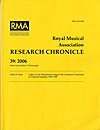 Ladies in the Wheatstone Ledgers: the Gendered Concertina in Victorian England, 1835–1870
Ladies in the Wheatstone Ledgers: the Gendered Concertina in Victorian England, 1835–1870
- by Allan W. Atlas
- This study looks at the 978 women for whom there are 1,769 transactions—about 12% of the
total—recorded in nine extant Wheatstone & Co. sales ledgers that list the firm’s day-to-day sales
from April 1835 to May 1870. It is in two parts: (1) an Introduction, which analyses the data presented
in the Inventory from a demographic-sociological point of view and places Wheatstone’s commerce
with women into the context of its business activity as a whole; and (2) the Inventory (with
three appendices), which lists every transaction for each of the 978 women, identifies as many of them
as possible, and offers a miscellany of comments about both the women and the transactions.
Royal Musical Association Research Chronicle v. 39 (2006). 239 pages.
Briefly,
the roster of Wheatstone’s female customers reads like a list of Victorian England’s rich-and-famous:
the Duchess of Wellington and 146 other members of the titled aristocracy (more than twice as many
as their male counterparts), the fabulously wealthy philanthropist Angela Burdett Coutts, members
of the landed gentry, and such mainstays of London’s musical life as the guitarist Madame R. Sidney
Pratten, the organist Elizabeth Mounsey, and the contralto Helen Charlotte Dolby, as well as a large
number of Professors of Concertina.
- Posted 21 March 2007
- » read full article
-
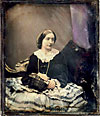 Ms Mary Baker with Concertina, c. 1857
Ms Mary Baker with Concertina, c. 1857
- Notes by Pat Shipman
- Mary Baker (d. 1882) seems to be the only woman named in the Wheatstone Concertina Ledgers (listed in
Allan W. Atlas, “Ladies in the Wheatstone Ledgers”) whom we can see with her concertina in hand, in a
daguerreotype dated c. 1857. Mary Baker’s brother (Samuel Baker) with his second wife explored central
Africa in search of the source of the Nile, and discovered Lake Albert in 1864, for which he was knighted in 1866.
As published in
PICA [Papers of the International Concertina Association], Vol. 3 (2006), pp. 36-37.
Better-quality colour photographs have been substituted for those originally published.
- Posted 21 March 2007
- » read full article
-
 Signor Alsepti and “Regondi’s Golden Exercise”
Signor Alsepti and “Regondi’s Golden Exercise”
-
by Allan Atlas
-
Discussion and explanation with new fingering of a celebrated excercise from James Alsepti's English tutor,
published by Lachenal c. 1895, with the explanation “The following exercise, which has never before been
published, was taught to Signor Alsepti by Regondi. It is
very difficult for all instruments, especially the Concertina, and to thoroughly master it with the correct
fingering &c. will enable the Pupil to play passages in all keys.”.
As published in
Concertina World 426 supplement (2003) pp. 1-8.
-
Posted 22 December 2003
-
» read full article
-
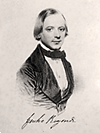 Wheatstone, His Sighing Reed, and The Great Regondi
Wheatstone, His Sighing Reed, and The Great Regondi
-
Presented by Bernard Richardson
-
BBC programme on the history and music of the English concertina,
focusing on its inventor Sir Charles Wheatstone and the first concertina virtuoso Giulio Regondi.
In addition to the presenter, Bernard Richardson, the program features (in order of appearance)
Allan Atlas, Neil Wayne, Brian Bowers, Alistair Anderson, Douglas Rogers, Jenny Cox, and Dave Townsend.
BBC Radio4 programme broadcast 27 November 2007.
Includes links to audio files of the entire programme in WMA format and MP3 format.
-
Posted 27 November 2007
-
» read full article
-
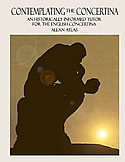 Contemplating the Concertina: An Historically-Informed Tutor for the English Concertina
Contemplating the Concertina: An Historically-Informed Tutor for the English Concertina
-
by Allan Atlas
-
This is the first tutor
for the English concertina intended specifically for
intermediate and advanced players. It is written with an eye toward both the
history of the instrument and how it has been played since Victorian times.
Examples and exercises include music—both “classical” and
“folk”—from the seventeenth century to the present day.
Chapters deal with holding the instrument (with illustrations), manipulating the bellows (the
most extensive discussion in print), single-note technique, and playing chords
and contrapuntal textures.
Published by The Button Box,
Amherst, Massachusetts, from whom it can be ordered over the web.
-
Posted 01 October 2003
-
» go to website
-
 Center for the Study of Free-Reed Instruments
Center for the Study of Free-Reed Instruments
-
by Allan Atlas
-
The CSFRI, part of the Doctoral Program in Music
at the Graduate Center, City University of New York, is
a resource for the scholarly study of all free-reed instruments
(sheng, harmonica, accordion, etc.)
and contains much of interest to concertinists. The site has news
of upcoming concerts, and a listing of books, articles,
recordings, and research material available at the Center's archives.
CSFRI published The Free-Reed Journal (four volumes, 1999–2003),
and now co-publishes the
Papers of the International Concertina Association (PICA)
with the ICA (2004– ).
-
-
Posted 15 February 2003
-
» go to website
Do you know another resource that we should include?
Tell us about it.
Reprinted from the Concertina Library
http://www.concertina.com
© Copyright 2000– by Allan Atlas
|
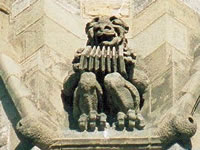
Gargoyle playing concertina,
high on Peace Tower,
Parliament Hill, Ottawa
|





